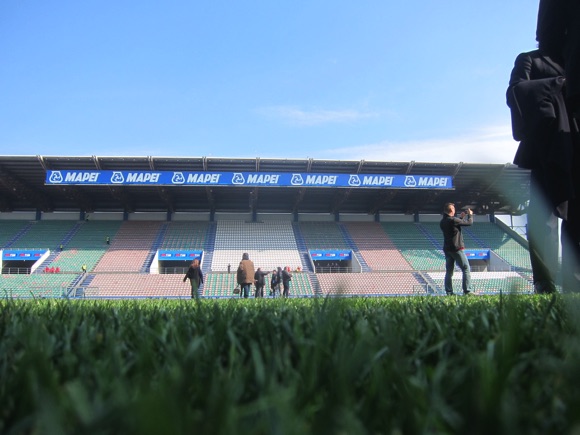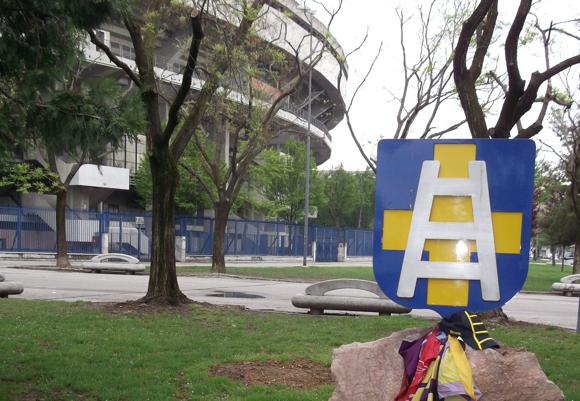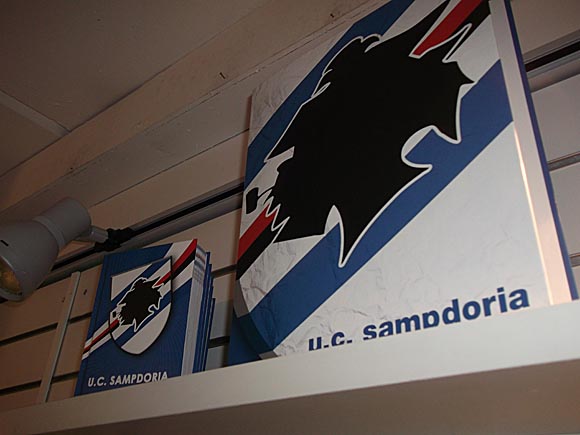A fan’s guide – the club from early doors to today
Promoted to the elite for the first time in 2013, Sassuolo Calcio performed an even greater miracle to stay there – and qualify for Europe in 2016.
It could perhaps be called the Miracle of Berardi. Looking a cert for relegation after the first four games in 2013-14, Sassuolo dug in to claim the occasional point before Italian under-21 striker Domenico Berardi upped and scored hatfuls of vital goals. With four in half-an-hour against Milan in January 2014, Sassuolo gained an unlikely 4-3 win, and clambered from the bottom of the table.
In May 2015, it was Berardi’s hat-trick against Milan that sealed a reasonably comfortable mid-table place for the Neroverdi. His performances led to a call-up to the national squad. By 2021, Berardi was responsible for two assists in Italy’s winning run to the Euro 2020 final, in which he came on to score the first penalty in the decisive shoot-out.

Club teammate Manuel Locatelli was another hero in Italy’s triumph, evidence of Sassuolo’s status in the domestic game. In 2021, only goal difference compared to Roma’s prevented further European qualification by the narrowest of margins. Relegation battles feel like a thing of the past.
Before they hit the big time, Sassuolo had little to show for a near century of football. Playing mainly other little clubs from around Reggio Emilia, Sassuolo gained promotion to Serie D in 1967-68. They changed their colours to green and black and began playing at the new municipal stadium of Enzo Ricci. Ex-Bologna star Ezio Pascutti came in as coach but still Sassuolo swam in the backwaters of Serie D and the regional leagues.
In the early 1980s, Giorgio Squinzi, son of the founder of Milan-based paint company Mapei, began to invest in the club. Mapei became the main sponsors and the club moved into new offices at piazza Risorgimento, by the stadium.

Sassuolo climbed from Serie D to C2, but slipped back after Squinzi shifted his investments into cycling. He then took over the club again in 2002, when Sassuolo won a C2 play-off with Faenza. In 2006 came C1 status, Sassuolo winning a play-off with Sansovino.
From there, after decades in the doldrums, Sassuolo simply took off. That first season the Neroverdi made the play-offs; the second, under later Juventus coach Massimiliano Allegri, they gained promotion to Serie B.
Moving home games to nearby Modena, Sassuolo led the league at Christmas but slipped back. It was star player Simone Missiroli, ‘il Missile’, who grabbed the decisive, late goal against fellow promotion contenders Livorno. Sassuolo were up after only five seasons in Serie B – and a decade after industrialist Giorgio Squinzi took over as owner.

Coach Eusebio Di Francesco then kept Sassuolo up thanks to an unexpected winning run in the spring of 2014. Sacked in January, the former Italian international midfielder returned in March to save the day for the Neroverdi.
With home games being played at the Mapei Stadium-Città del Tricolore on the bleak outskirts of Reggio Emilia, Sassuolo gradually became savvy at Serie A football. Finishing 6th in 2015-16 after a 3-1 win over Inter, Sassuolo reached Europe for the first time, overcoming Lucerne and Red Star Belgrade in the Europa League thanks to comfortable home wins and goals from the ever-consistent Domenico Berardi.
By no means disgraced in the group stage, beating Bilbao handsomely, the Neroverdi nonetheless failed to progress. League form picked up with the arrival of adventurous coach Roberto De Zerbi in 2018, Sassuolo coming close to further European football in 2020 and 2021.
Providing three playing members of Italy’s winning Euro 2020 squad – more than Milan, Inter or Roma – and approaching a decade-long run in Serie A, Sassuolo are no longer a quirky anomaly but a solid presence in the higher echelons of the domestic game.






Stadium Guide
The field of dreams – and the stands around it





The Enzo Ricci stadium being far too small, the Neroverdi played in Modena as they sought promotion from Serie B from 2008 to 2013. After promotion, owner Giorgio Squinzi plumped for Reggio Emilia’s Mapei Stadium-Città del Tricolore as Sassuolo’s home ground for Serie A purposes.
Home of third-flight club Reggiana (and, for one season, Sassuolo’s local rivals Carpi), the former Stadio Giglio was the first stadium in Italy to be built by the club itself, in 1994-95. Fittingly, the first visitors were Juventus, held up as the prime example of moving away from the municipal model.
With an initial capacity of 26,000, this was also the first Italian stadium known by its sponsored name (Giglio being a local dairy company), with skyboxes, closed-circuit TV and heated benches for the coach and subs. That same year, the Giglio hosted a Euro 96 qualifying game with Lithuania.




In 2004, with Reggiana having slipped from that brief season in Serie A down to C1, the Giglio was restructured to accommodate the adjoining I Petali, a retail and leisure complex with an 11-screen cinema. Stadium capacity was reduced to its current 20,000.
Having adopted the municipally sponsored name of Città del Tricolore, the venue also adopted Mapei Stadium upon signing a two-season agreement with Sassuolo in the summer of 2013.
Home fans occupy the Curva Sud, away ones the Curva Nord. The best seats are in the Tribuna, more affordable ones with a decent view in the Distinti.
getting there
Getting to the stadium – tips and timings




The stadium is on the north-eastern outskirts of town, with its own stop, Reggio Stadio Giglio, on the Reggio Emilia-Guastalla regional FER rail line, 5mins/2 stops from Reggio station. There’s an hourly service during the week, four a day at weekends (12min journey time).
From the stop by the post office outside Reggio station, Minibus H runs Mon-Fri only, every 15mins (15min journey time) to the Parcheggio Stadio Giglio, the car park alongside the stadium. At weekends, the only regular public transport is bus 5 every 30mins from downtown Teatro Ariosto, which stops at via Duo and via Ruini near the stadium.
A taxi from the station should cost about €12. The walk would take at least 30mins as no road follows the rail line – head up viale Reina Margherita then take the last right, via del Chionso, before the ring road. The stadium is ahead of you on viale S Taddei.
From Sassuolo, there hourly rickety FER trains to Reggio Emilia (35mins) during the week, four a day (8am, 11am, 3pm, 6pm) at weekends (50min journey time).
getting in
Buying tickets – when, where, how and how much

Availability is rarely an issue – unless Milan are the visitors for a title decider on the last day of the season, as in 2022. Sales to away fans in the Tribuna Nord are not permitted on match days.
Tickets go on sale early of game week from the club store (Mon 3.30pm-7.30pm, Mon-Wed, Fri-Sat 9.30am-1pm, 3.30pm-7.30pm, Thur 3.30pm-7.30pm) at piazza Giuseppe Garibaldi 15 in Sassuolo, and via outlets of Viva Ticket. In Reggio Emilia, these include the box office (Tue & Fri 9am-1pm, Wed 3pm-6pm, Sat 10am-1pm) of the Nuovo Teatro San Prospero (via Guidelli 5) and the Tabaccheria Scandallari Lorenzo (Mon-Sat 8am-1pm, 3pm-8pm, Sun 9am-1pm) at via del Gattaglio 28A ,
There are online through the club. The biglietteria at the Reggiana stadium is by the car park, to the right of the main stand as you approach from town.
Prices for an average Serie A game are €20 in the Tribuna Sud (home) and Nord (away), €35-45 in the distinti (laterale/centrale), and €40-65 in the main stand, Tribuna (inferiore, superiore, centrale), lower, upper and central.
what to buy
Shirts, kits, merchandise and gifts


Green-and-black merchandise is available from the club store (Mon 3.30pm-7.30pm, Mon-Wed, Fri-Sat 9.30am-1pm, 3.30pm-7.30pm, Thur 3.30pm-7.30pm) at piazza Giuseppe Garibaldi 15 in Sassuolo. Second kits are currently white with a freaky green-and-black pattern in a kind of napkin arrangement, third choice is a Wycombe-ish light blue with dark-blue checks, with black sleeves and green trim.
Slippers, scarves and hats carry the club logo, flowers sprouting up behind railings in one quarter, taken from the town’s coat of arms.
Where to Drink
Pre-match beers for fans and casual visitors



The nearest pub, Rebus, 300 metres from the stadium at the junction of via Meuccio Ruini and via Gramsci, appeals to an urban crowd with craft beers and burgers. Seats line the outdoor pavement and a big screen is set up for match days. Close by, Le Torri has a handy terrace, with a TV inside. Booze is served though fancy pastries are the speciality.
For a sit-down pre-match meal in traditional surroundings, superior restaurant Trattoria del Buontempone can offer pizza and craft beer – it’s about 10mins from the stadium at viale Regina Margherita 53.
In the mall surrounding the stadium, I Petali, the most bar-like of the uninspiring chain eateries is being Dispensa Emilia, which dispenses tigelle, stuffed flat rolls, and local Lambrusco wine.


























